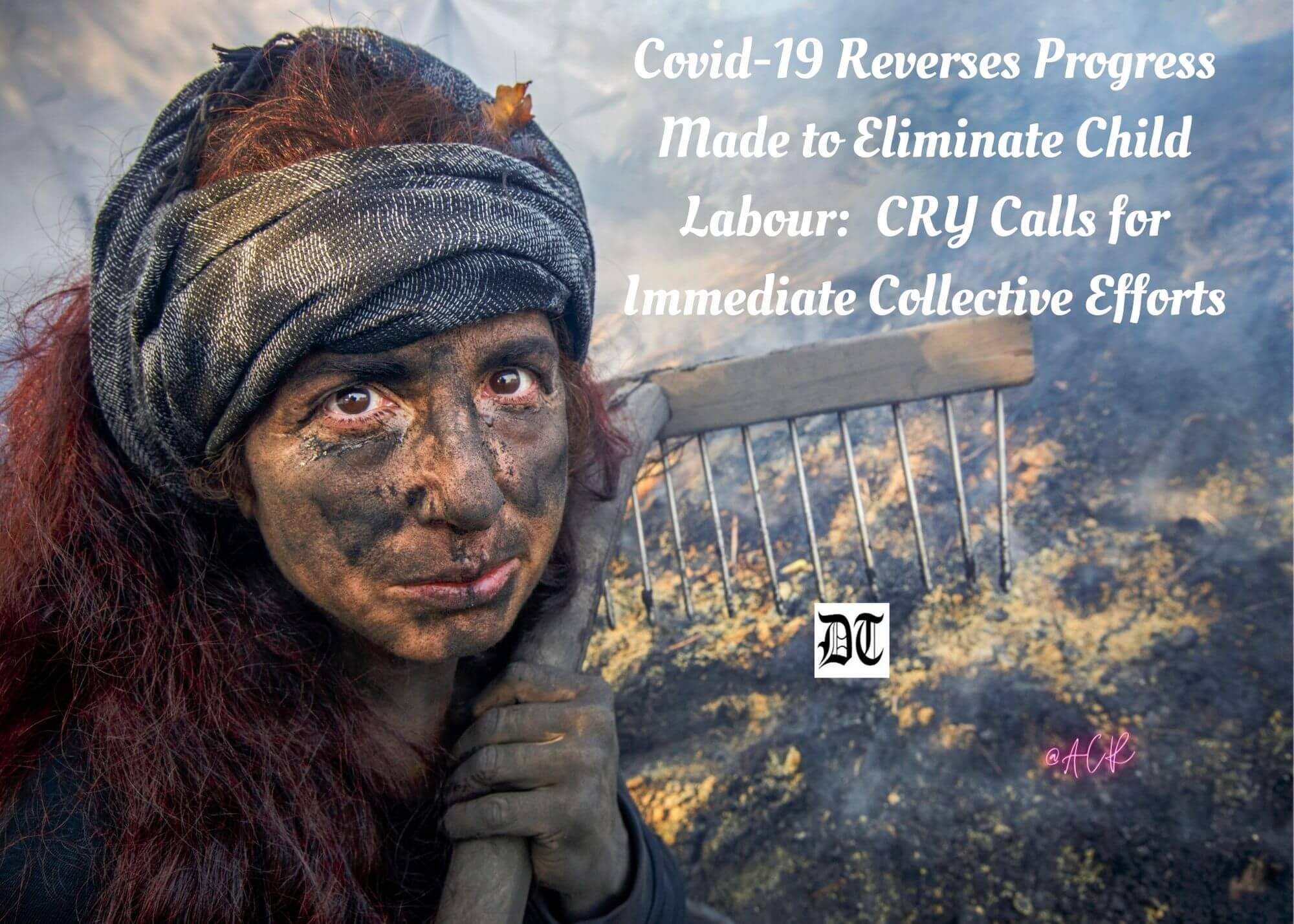On the occasion of World Day against Child – Labour 2021, a study of CRY finds that the pandemic has reversed the progress made to eliminate child labour. CRY calls for immediate collective efforts. A report for Different Truths.
As the world gears up to observe the World Day against Child Labour (WDACL) tomorrow, little of the celebratory uproar reaches Lakshmi or Babua(names changed to protect identity). Both Lakshmi, a girl of 14 living in a slum in Uttar Pradesh, and Babua, a 15-year-old boy hailing from a tribal village in Odisha, had to discontinue their studies and been pushed to child labour in the year of the dreadful pandemic, stated a media release.
Coming from families with no financial resources and many mouths to feed, these two teens had to halt their dream of continuing education and join manual work.
Coming from families with no financial resources and many mouths to feed, these two teens had to halt their dream of continuing education and join manual work. While Babua started working in a brick kiln near his village, Lakshmi helped her mother earn some extra money – only to support their family to make ends meet amid the crisis.
However, timely interventions by local grassroots level NGOs supported by CRY (Child Rights and You) brought both the children out of the manual work and put them back to school. Today, Babua and Lakshmi are not only focusing on completing their education, but they have also become role models for other children in their areas, the release added.
…these stories … are also grim testimonies to how the pandemic has increased chances of children slipping through the cracks and falling prey to the menace of child labour.
While these stories go a long way to underscore the efforts made by small NGOs during testing times, these are also grim testimonies to how the pandemic has increased chances of children slipping through the cracks and falling prey to the menace of child labour.
“Going by the numbers from CRY-supported intervention areas across states, in 2020, close to 4000 cases of child labour were prevented or referred for rescue and support. These numbers suggest that even though our collective efforts are on the right track, there’s still a long way to go and fully address the vulnerabilities of children,” Puja Marwaha, the CEO at CRY observed.
“Amid the pandemic, scores of children may have been pushed into child labour due to massive loss of livelihood…”
“Amid the pandemic, scores of children may have been pushed into child labour due to massive loss of livelihood, as there’s a dire need of extra pairs of hands at many families. With almost no income in the pandemic times, if the choice is between feeding empty stomachs and paying off school fees for adolescent children – it’s anybody’s guess what the struggling families will go for…” Puja commented, according to the media release.
“Prolonged closure of schools and lack of resources like no smart phones and internet connections, uninterrupted supply of electricity, space to take up online classes etc. to access e-learning has only exacerbated the situation by pushing marginalised children further away from education,” she further explained.
For adolescent children above the age of 14 years and continuing education beyond the 8th standard the problem is much graver…
For adolescent children above the age of 14 years and continuing education beyond the 8th standard the problem is much graver, since the Right to Education (RTE) Act guarantees education only till a child reaches 14; and the Child and adolescent Labour (Prohibition and Regulation) Act, 1986 (CALPRA) allows children within 15 to 18 years to be engaged in labour as long as it is outside the list of ‘hazardous occupations and processes’[i]– thus pushing children further away from the promise of universal education up to the age of 18 years, as enshrined in the National Education Policy (NEP).
Impacts of the COVID-19 pandemic on child labour are manifold, too. Though a decade of the RTE-era significantly improved the status of enrolment of children in schools, retention remained a major challenge. Vulnerable children who have been facing long-term detachment from school (due to the pandemic) and helping family by entering the workforce or at home will significantly aggravate the drop-out issue, it was stressed in the release.
The latest report on the global estimates 2020 by ILO and UNICEF reveals that, globally, significant shares of children in child labour are out of school…
The latest report on the global estimates 2020 by ILO and UNICEF reveals that, globally, significant shares of children in child labour are out of school, and across the countries in Central and Southern Asia more than one-third (35.3 per cent) of children between 5 – 14 years in child labour are not attending schools. In the Indian context, census 2011 data reveals that more than half (51 per cent) of total child labourers within the age of 5-14 years are not attending educational institutions. According to more recent figures from Periodic Labour Force Survey (PLFS 2017-18), close to 6 percent of children in the age-group of 5 – 14 years were out of school, and a considerable number of them were engaged in work[ii].
The ILO report further stresses that, globally, more than 70 percent child labour is in family and agriculture and in rural areas.
CRY’s experiences from the grassroots suggest that bringing the dropped-out children back to school after a year or more would prove to be extremely difficult.
CRY’s experiences from the grassroots suggest that bringing the dropped-out children back to school after a year or more would prove to be extremely difficult. While the second wave of the pandemic may have ruined the hope of getting children back to school this academic year any soon, the forthcoming waves may snatch away two consecutive years of education, thereby causing irreversible damage to the future of children, especially the marginalised ones living under the shadows of multi-dimensional poverty, it was pointed out.
Commenting on the retrogressive trends, Puja said, “Over the past couple of decades, it had been a hard battle to ensure that our children are in schools and thus well-protected from being pushed into child labour – it had taken huge efforts, resources, finances as well as changing community outlooks – and we have reasons to be worried that much of the success can go to waste.”
The report by ILO and UNICEF almost echoes the worry as it states that “The COVID-19 crisis threatens to further erode global progress against child labour…
The report by ILO and UNICEF almost echoes the worry as it states that “The COVID-19 crisis threatens to further erode global progress against child labour unless urgent mitigation measures are taken. New analysis suggests a further 8.9 million children will be in child labour by the end of 2022 as a result of rising poverty driven by the pandemic.” The report further estimates that there are 26.3 million of children within 5 – 17 years engaged in labour in Central and Southern Asia. The report also warns that without accelerated action, globally, close to 140 million children will be in child labour in 2025, and 125 million in 2030.
This year’s WDACL focuses on action taken for the ‘2021 International Year for the Elimination of Child Labour’ and will be celebrated with a ‘Week of Action’ (from 10- 17 June 2021), providing organisations and agencies extended time and opportunity to strengthen their efforts to address vulnerabilities of children and eliminate child labour, stated the media release.
CRY, a leading Indian non-profit organisation working towards ensuring children’s rights believes that the government needs to make concerted efforts to improve systems…
CRY, a leading Indian non-profit organisation working towards ensuring children’s rights believes that the government needs to make concerted efforts to improve systems related to children’s education and protection mechanisms and strengthen social security schemes to help families sustain themselves – now more than ever, particularly in the backdrop of the pandemic.
“We need a robust child protection and social security system which has got seriously impacted due to COVID pushing children into labour. Stringent enforcement of the child labour law, the Integrated Child Protection Services Scheme is critical to safeguard children from the impact of the COVID-19, including the fall outs of the economic slowdown,” Puja Marwaha said.
She also underscored the role the Civil Society Organisations (CSO) can play in eliminating child labour…
She also underscored the role the Civil Society Organisations (CSO) can play in eliminating child labour, by reaching out to the last mile child and families and help government to deliver the social protection schemes to children and their families. “CSOs and NGOs should also participate in forums and programs wherein they can deliberate on the issue with other representatives and put forth their perspective in charting out a roadmap for elimination of child labour,” Puja added, according to the media release.
[i] The list of hazardous occupations and processes of the Child Labour Prohibition and Regulation Act, 1986 added up to 83 (18 hazardous occupations and 65 hazardous processes) until 2008. However, this list has been reduced to only 38 after the 2016 amendment to the child labour legislation.
[ii] PLFS data provides the percentage distribution of persons by usual status (ps+ss) for each age-group. In the age category 5-9 and 10-14 (rural and urban, persons), 92.3% and 94.8% were attending schools. Among children who were not attending schools, 0.8% in 5-9 age category and 2.0% in the 10-14 age category were attending to domestic duties. 0.3 % and 0.6% respectively were attending to domestic duties and was also engaged in free collection of goods (vegetables, roots, firewood, cattle feed etc.), sewing, tailoring, weaving, etc. for household use. 5.9% (5-9) and 0.9% (10-14) were engaged in other activities (including begging, prostitution etc.). 0.6% in the age group 10-14 years were engaged in household enterprises, 0.2% worked as casual labour in other types of works, 0.4% sought work – or did not seek – but were available for work.
Visuals by Different Truths





 By
By


 By
By